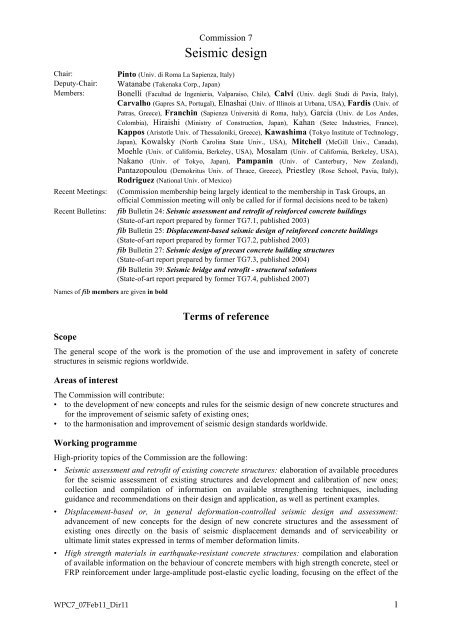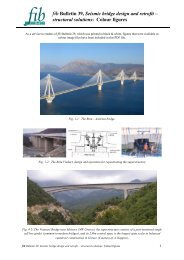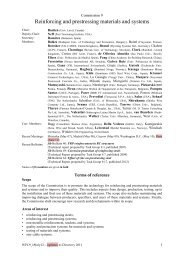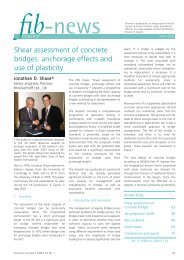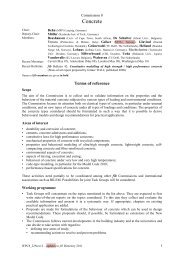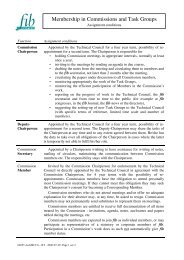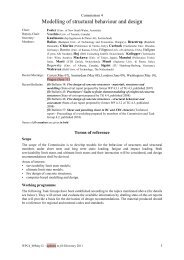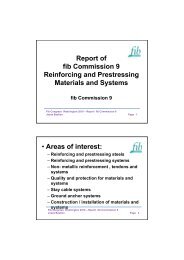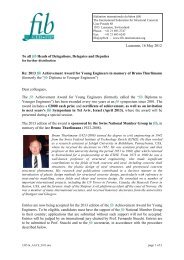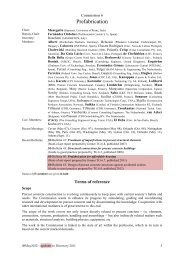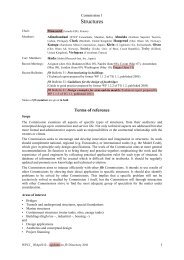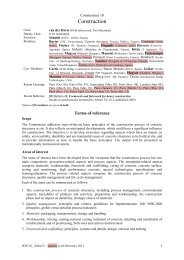Seismic design - The International Federation for Structural Concrete
Seismic design - The International Federation for Structural Concrete
Seismic design - The International Federation for Structural Concrete
Create successful ePaper yourself
Turn your PDF publications into a flip-book with our unique Google optimized e-Paper software.
Commission 7<br />
<strong>Seismic</strong> <strong>design</strong><br />
Chair: Pinto (Univ. di Roma La Sapienza, Italy)<br />
Deputy-Chair: Watanabe (Takenaka Corp., Japan)<br />
Members: Bonelli (Facultad de Ingenieria, Valparaiso, Chile), Calvi (Univ. degli Studi di Pavia, Italy),<br />
Carvalho (Gapres SA, Portugal), Elnashai (Univ. of Illinois at Urbana, USA), Fardis (Univ. of<br />
Patras, Greece), Franchin (Sapienza Università di Roma, Italy), Garcia (Univ. de Los Andes,<br />
Colombia), Hiraishi (Ministry of Construction, Japan), Kahan (Setec Industries, France),<br />
Kappos (Aristotle Univ. of <strong>The</strong>ssaloniki, Greece), Kawashima (Tokyo Institute of Technology,<br />
Japan), Kowalsky (North Carolina State Univ., USA), Mitchell (McGill Univ., Canada),<br />
Moehle (Univ. of Cali<strong>for</strong>nia, Berkeley, USA), Mosalam (Univ. of Cali<strong>for</strong>nia, Berkeley, USA),<br />
Nakano (Univ. of Tokyo, Japan), Pampanin (Univ. of Canterbury, New Zealand),<br />
Pantazopoulou (Demokritus Univ. of Thrace, Greece), Priestley (Rose School, Pavia, Italy),<br />
Rodriguez (National Univ. of Mexico)<br />
Recent Meetings: (Commission membership being largely identical to the membership in Task Groups, an<br />
official Commission meeting will only be called <strong>for</strong> if <strong>for</strong>mal decisions need to be taken)<br />
Recent Bulletins: fib Bulletin 24: <strong>Seismic</strong> assessment and retrofit of rein<strong>for</strong>ced concrete buildings<br />
(State-of-art report prepared by <strong>for</strong>mer TG7.1, published 2003)<br />
fib Bulletin 25: Displacement-based seismic <strong>design</strong> of rein<strong>for</strong>ced concrete buildings<br />
(State-of-art report prepared by <strong>for</strong>mer TG7.2, published 2003)<br />
fib Bulletin 27: <strong>Seismic</strong> <strong>design</strong> of precast concrete building structures<br />
(State-of-art report prepared by <strong>for</strong>mer TG7.3, published 2004)<br />
fib Bulletin 39: <strong>Seismic</strong> bridge and retrofit - structural solutions<br />
(State-of-art report prepared by <strong>for</strong>mer TG7.4, published 2007)<br />
Names of fib members are given in bold<br />
Scope<br />
Terms of reference<br />
<strong>The</strong> general scope of the work is the promotion of the use and improvement in safety of concrete<br />
structures in seismic regions worldwide.<br />
Areas of interest<br />
<strong>The</strong> Commission will contribute:<br />
• to the development of new concepts and rules <strong>for</strong> the seismic <strong>design</strong> of new concrete structures and<br />
<strong>for</strong> the improvement of seismic safety of existing ones;<br />
• to the harmonisation and improvement of seismic <strong>design</strong> standards worldwide.<br />
Working programme<br />
High-priority topics of the Commission are the following:<br />
• <strong>Seismic</strong> assessment and retrofit of existing concrete structures: elaboration of available procedures<br />
<strong>for</strong> the seismic assessment of existing structures and development and calibration of new ones;<br />
collection and compilation of in<strong>for</strong>mation on available strengthening techniques, including<br />
guidance and recommendations on their <strong>design</strong> and application, as well as pertinent examples.<br />
• Displacement-based or, in general de<strong>for</strong>mation-controlled seismic <strong>design</strong> and assessment:<br />
advancement of new concepts <strong>for</strong> the <strong>design</strong> of new concrete structures and the assessment of<br />
existing ones directly on the basis of seismic displacement demands and of serviceability or<br />
ultimate limit states expressed in terms of member de<strong>for</strong>mation limits.<br />
• High strength materials in earthquake-resistant concrete structures: compilation and elaboration<br />
of available in<strong>for</strong>mation on the behaviour of concrete members with high strength concrete, steel or<br />
FRP rein<strong>for</strong>cement under large-amplitude post-elastic cyclic loading, focusing on the effect of the<br />
WPC7_07Feb11_Dir11 1
inherent brittleness of high strength materials on the de<strong>for</strong>mability and the energy-dissipation<br />
capacity of concrete members; adaptation of member dimensioning and detailing rules and of<br />
overall seismic <strong>design</strong> concepts to the use of high strength materials.<br />
• Earthquake-resistant prefabricated concrete structures (in collaboration with fib Commission 6,<br />
Prefabrication): compilation and elaboration of data on the behaviour of connections of precast<br />
elements under large-amplitude cyclic loading; development of recommendations and proposals <strong>for</strong><br />
code rules <strong>for</strong> the dimensioning and detailing of connections <strong>for</strong> earthquake resistance; assessment<br />
and rating of common precast concrete construction types of configurations in terms of earthquake<br />
resistance and robustness and recommendations <strong>for</strong> their improvement.<br />
• Earthquake-resistant prestressed concrete structures: compilation and elaboration of available<br />
experimental data on the behaviour of prestressed concrete members under large-amplitude postelastic<br />
load cycles, focusing on the effect of prestress on energy dissipation capacity and ultimate<br />
de<strong>for</strong>mation; development of recommendations and proposals <strong>for</strong> code rules <strong>for</strong> the dimensioning<br />
and detailing of earthquake-resistant prestressed members, and of <strong>design</strong> concepts of prestressed<br />
concrete structures.<br />
• Wall systems in seismic regions: study of the seismic behaviour of structural systems which depend<br />
mainly on structural walls <strong>for</strong> resistance against horizontal actions, with emphasis on the costeffectiveness<br />
of large lightly-rein<strong>for</strong>ced walls; development of recommendations and of code rule<br />
proposals <strong>for</strong> earthquake-resistant dimensioning and detailing of walls with complex crosssectional<br />
shapes, including coupled walls.<br />
• Moment resisting frame systems in seismic regions: study of the seismic <strong>design</strong> provisions of major<br />
codes of countries with a view to comparing capacity <strong>design</strong> approaches and detailing provisions<br />
<strong>for</strong> moment resisting frames <strong>for</strong> a range of levels of seismic <strong>design</strong> <strong>for</strong>ces corresponding to various<br />
structure ductility demands; particular emphasis to be placed on appropriate capacity <strong>design</strong> and<br />
detailing procedures <strong>for</strong> structural elements and joints.<br />
• <strong>Seismic</strong> isolation: development of criteria and methods <strong>for</strong> the <strong>design</strong> of seismically isolated<br />
buildings and bridges. Main topics to be covered include: definition of per<strong>for</strong>mance levels,<br />
calibration of the safety elements needed to achieve given per<strong>for</strong>mance objectives, modelling of the<br />
behaviour of different categories of isolating / dissipating devices, determination of the respective<br />
fields of applicability of equivalent linear and non-linear analysis methods, assessment of the effect<br />
of non-synchronous motion in the case of bridges.<br />
• <strong>Concrete</strong> silos, tanks and chimneys: development of criteria and methods <strong>for</strong> the <strong>design</strong> of concrete<br />
containment or similar special structures against seismic action. Main topics to be covered include:<br />
definition of per<strong>for</strong>mance levels, interaction between contained material and structure, non<br />
conventional shapes, inelastic response and <strong>design</strong> <strong>for</strong> ductility, seismic isolation.<br />
• Tall buildings: development of criteria and methods <strong>for</strong> the <strong>design</strong> of tall buildings against seismic<br />
action. Main topics to be covered include: structural systems (including mixed ones comprising<br />
concrete cores and steel or composite frames), definition of per<strong>for</strong>mance levels, appropriate<br />
methods of analysis, definition of input ground motion <strong>for</strong> long-period structures, definition of<br />
input ground motion <strong>for</strong> structures with significant embedded portions, seismic isolation of tall<br />
buildings.<br />
• Per<strong>for</strong>mance-based seismic <strong>design</strong>: development of a document <strong>for</strong> direct <strong>design</strong> of buildings<br />
aimed at ensuring compliance with specified probabilistically-defined per<strong>for</strong>mance objectives. <strong>The</strong><br />
<strong>design</strong> methods will be of the displacement-based type and will account explicitly <strong>for</strong> uncertainties<br />
in the seismic action, the structural system, the foundation medium, etc.<br />
<strong>The</strong> Commission is expected to follow the worldwide developments and needs and to identify<br />
additional topics of interest and priorities.<br />
In addition to the Task Groups described below, the establishment of two further groups dealing with<br />
seismic <strong>design</strong> of silos/tanks and tall buildings is planned in the near future.<br />
WPC7_07Feb11_Dir11 2
Task Group<br />
TG 7.5 <strong>Seismic</strong> <strong>design</strong> of buildings incorporating high<br />
per<strong>for</strong>mance materials<br />
Conveners: Watanabe (Takenaka Corp., Japan), Pampanin (Univ. of Canterbury, New Zealand)<br />
Secretary: Nishiyama (Kyoto Univ., Japan)<br />
Members: Christopoulos (Univ. of Toronto, Canada), Dazio (ETH Zürich, Switzerland), Elnashai (Univ.<br />
of Illinois at Urbana, USA), Franchin (Univ. di Roma La Sapienza, Italy), Fukuyama (Building<br />
Research Institute, Japan), Kelly (Univ. of Cali<strong>for</strong>nia at Berkeley, USA), Komuro (Taisei<br />
Corporation, Japan), Konstantinidis (Egnatia Odos SA, Greece), Li (Nanyang Technological<br />
Univ., Singapore), McSaveney (Golden Bay Cement, New Zealand), Mitchell (McGill Univ.,<br />
Canada), Moehle (Univ. of Cali<strong>for</strong>nia at Berkeley, USA), Noguchi (Univ. of Tokyo, Japan),<br />
O'Leary (Sinclair Knight Merz Ltd., New Zealand), Pantazopoulou (Demokritus Univ. of<br />
Thrace, Greece), Parra-Montesinos (Univ. of Michigan, USA), Paultre (Univ. of Sherbrooke,<br />
Canada), Rodriguez (National Univ. of Mexico, Mexico)<br />
Recent Meetings: Kobe (05), Naples (June 06)<br />
Names of fib members are given in bold<br />
Terms of reference<br />
<strong>The</strong> use of high strength concrete and high strength rein<strong>for</strong>cement has been widespread <strong>for</strong> the precast<br />
and the cast-in-situ construction of building structures. In some cases special response control<br />
materials are incorporated to reduce the drift during the earthquake. On the other hand new precast<br />
structural seismic systems incorporating several types of high per<strong>for</strong>mance materials are being<br />
developed <strong>for</strong> the damage-controlled <strong>design</strong>. Task Group 7.5 will summarize the state of the art of<br />
these high per<strong>for</strong>mance materials and devices, including recent progress reported in important<br />
conferences in Tokyo 2009 and New Zealand 2011. <strong>The</strong> output of the task group should give<br />
engineers a guide <strong>for</strong> the seismic <strong>design</strong> of buildings incorporating high per<strong>for</strong>mance materials and<br />
promote the future development of high per<strong>for</strong>mance materials.<br />
Task Group<br />
TG 7.6 Critical comparison of major seismic <strong>design</strong> codes<br />
<strong>for</strong> buildings<br />
Conveners: Pinto (Univ. di Roma La Sapienza, Italy)<br />
Secretary: Kuramoto (Toyohashi Univ. of Technology, Japan)<br />
Members: Calvi (Univ. degli Studi di Pavia, Italy), Carvalho (Gapres SA, Lisbon, Portugal), Fardis<br />
(Univ. of Patras, Greece), Fenwick (Univ. of Canterbury, New Zealand), Garcia (Univ. de Los<br />
Andes, Colombia), Kappos (Aristotle Univ. of <strong>The</strong>ssaloniki, Greece), Kolias (DENCO Ltd.,<br />
Greece), Li (Nanyang Technological University, Singapore), Lupoi (Univ. of Rome "La Sapienza",<br />
Italy), Maffei (Ruther<strong>for</strong>d & Chekene, USA), Mitchell (McGill Univ., Canada), Moehle (Univ.<br />
of Cali<strong>for</strong>nia, USA), Pampanin (Univ. of Canterbury, New Zealand), Pantazopoulou<br />
(Demokritus Univ. of Thrace), Paultre (Univ. of Sherbrooke, Canada), Rodriguez (National<br />
Univ. of Mexico), Shiohara (Univ. of Tokyo, Japan), Watanabe (Takenaka Corp., Japan)<br />
Recent Meetings: Naples (June 06)<br />
Names of fib members are given in bold<br />
Terms of reference<br />
A critical comparison of current seismic codes <strong>for</strong> the <strong>design</strong> of new concrete building structures in<br />
Europe, Japan, New Zealand and North America will be conducted. <strong>The</strong> comparison will include the<br />
demand side (<strong>design</strong> seismic <strong>for</strong>ces, capacity <strong>design</strong> actions, <strong>design</strong> seismic displacements and<br />
associated <strong>design</strong> ductilities; and the capacity side (member and joint strengths - flexure, shear and<br />
anchorage); hierarchies of strength attainment; de<strong>for</strong>mation capacity of mechanisms of inelastic<br />
WPC7_07Feb11_Dir11 3
de<strong>for</strong>mation; and the detailing of members and connections <strong>for</strong> the required strength and ductility. <strong>The</strong><br />
focus will be on some of the controversial aspects of the use of the capacity <strong>design</strong> approach (e.g.<br />
amplification factors <strong>for</strong> column bending moments and shears <strong>for</strong> strong column-weak beam <strong>design</strong>),<br />
the detailing of beams, columns and walls <strong>for</strong> ductility, and the detailing of beam-column joints <strong>for</strong><br />
shear, confinement and the limitation of bond slip. Buildings of rein<strong>for</strong>ced concrete, prestressed<br />
concrete, and combinations of both will be considered. <strong>The</strong> report will emphasize the outcome of the<br />
major differences between the current seismic codes.<br />
Task Group<br />
TG 7.7 Probabilistic per<strong>for</strong>mance-based seismic <strong>design</strong><br />
Convener: Pinto (Univ. di Roma La Sapienza, Italy)<br />
Members: Bazzuro (AIR Worldwide, San Francisco, USA), Elnashai (Univ. of Illinois at Urbana, USA),<br />
Franchin (Univ. di Roma La Sapienza, Italy), Haukaas (Univ. of British Columbia, Vancouver,<br />
Canada), Miranda (Stan<strong>for</strong>d Univ., USA), Moehle (Univ. of Cali<strong>for</strong>nia, Berkeley, USA),<br />
Mosalam (Univ. of Cali<strong>for</strong>nia, Berkeley, USA), Rui Pinho (EUCENTRE, Pavia, Italy),<br />
Vamvatsikos (Nat. Techn. Univ. Athens, Greece)<br />
Recent Meetings: Corfu (July 09), Washington (June 10), Vienna (Sept. 10)<br />
Names of fib members are given in bold<br />
Terms of reference<br />
<strong>The</strong> well-known Pacific Earthquake Engineering Research Center project is about to conclude a longterm<br />
ef<strong>for</strong>t to develop a methodology <strong>for</strong> the explicit evaluation of seismic per<strong>for</strong>mance of buildings,<br />
measured in terms of probability of exceeding a selected measure of damage/cost of use <strong>for</strong> decision<br />
makers. A procedure <strong>for</strong> direct <strong>design</strong> of a building to ensure desired per<strong>for</strong>mances with specified<br />
probabilities, a much more challenging problem, is still not available. On the other hand, much<br />
progress has been made towards deterministic per<strong>for</strong>mance-based seismic <strong>design</strong> through the<br />
development of displacement-based approaches, which start from a chosen inelastic de<strong>for</strong>med shape<br />
of the structure to apportion stiffness and strength of members. <strong>The</strong> group will strive to progress along<br />
these directions in order to produce a guidance document with a proposal <strong>for</strong> direct <strong>design</strong> of buildings<br />
aimed at ensuring compliance with specified probabilistically-defined per<strong>for</strong>mance objectives.<br />
WPC7_07Feb11_Dir11 4


